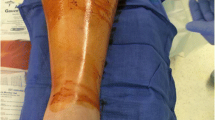Abstract
Intramedullary nailing is the “gold standard” for the treatment of shaft tibia fractures. It provides high rates of bone healing associated to low infection rates, and gives high stability for a safe limb motion.
We analyze advantages and complications of locked reamed intramedullary nailing in our experience in treating shaft tibia fractures.
Similar content being viewed by others
Bibliografia
Court-Brown CM, McBirnie J (1995) The epidemiology of tibial fractures. J Bone Joint Surg Br 77:417–421
Court-Brown CM, Will E, Christie J, McQueen MM (1996) Reamed or unreamed nailing for closed tibial fractures. A prospective study in Tscherne C1 fractures. J Bone Joint Surg Br 78:580–583
Ziran BH, Darowish M, Klatt BA et al (2004) Intramedullary nailing in open tibia fractures: a comparison of two techniques. Int Orthop 28:235–238
Finkemeier CG, Schmidt AH, Kyle RF et al (2000) A prospective, randomized study of intramedullary nails inserted with and without reaming for the treatment of open and closed fractures of the tibial shaft. J Orthop Trauma 14:187–193
Schemitsch EH, Kowalski MJ, Swiontkowski MF, Harrington RM (1995) Comparison of the effect of reamed and unreamed locked intramedullary nailing on blood flow in the callus and strength of union following fracture of the sheep tibia. J Orthop Res 13:382–389
Peindl RD, Zura RD, Vincent A et al (2004) Unstable proximal extraarticular tibia fractures: a biomechanical evaluation of four methods of fixation. J Orthop Trauma 18:540–545
Blachut PA, O’Brien PJ, Meek RN, Broekhuyse HM (1997) Interlocking intramedullary nailing with and without reaming for the treatment of closed fractures of the tibial shaft. A prospective, randomized study. J Bone Joint Surg Am 79:640–646
Krieg JC (2003) Proximal tibial fractures: current treatment, results, and problems. Injury 34[Suppl. 1]:2–10
Canadian Orthopaedic Trauma Society (2006) Reamed versus unreamed intramedullary nailing of the femur: comparison of the rate of ARDS in multiple injured patients. J Orthop Trauma 20:384–387
Author information
Authors and Affiliations
Rights and permissions
About this article
Cite this article
Longo, G., Salvo, G.C. L’inchiodamento tibiale. LO SCAL 22, 165–169 (2009). https://doi.org/10.1007/s11639-009-0007-0
Published:
Issue Date:
DOI: https://doi.org/10.1007/s11639-009-0007-0




